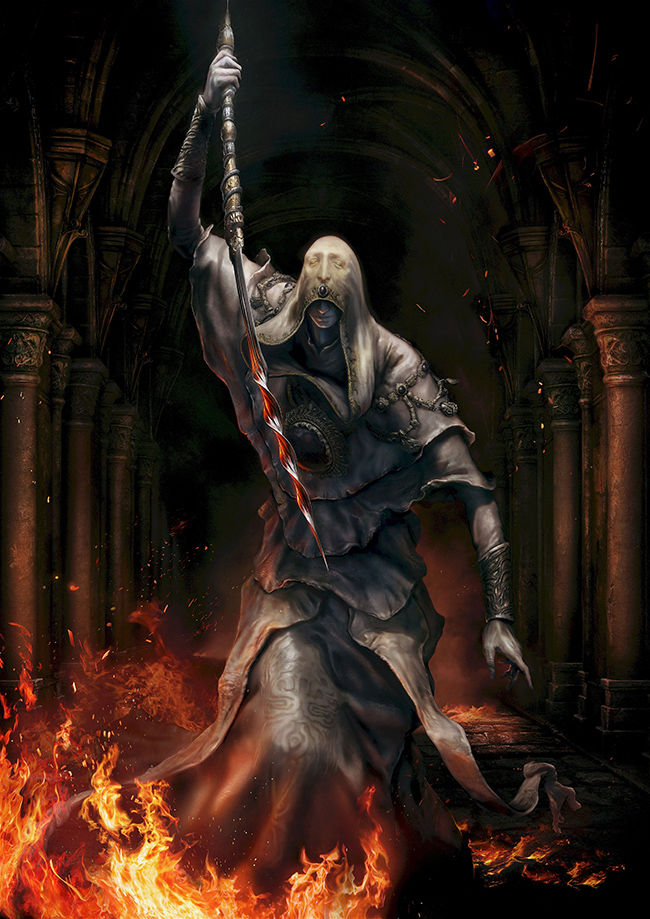For longtime fans of FromSoftware’s Souls series, Glaive Master Hodir is what’s known as a “skill check.” He’s not the toughest boss players will face—in fact, he’s acquired a reputation as one of the easiest—but the ramp-up in challenge presented by the encounter sends a clear signal to players: The real Elden Ring starts here.
But some struggle to clear that hurdle. On r/eldenring, the Reddit community dedicated to From’s newest tough-but-fair action RPG, user gamer_disease is one of the many who’ve recounted their struggles with the Glaive Master. With practice, gamer_disease has successfully tanked through the boss’s first phase by learning to parry—an essential lesson for anyone hoping to finish the game. But he ran into trouble during the second phase, when Hodir drops his signature glaive and pulls out a massive sword, slamming it into the ground for a devastating area-of-effect attack that stops the player in their tracks. “I’ve tried everything and I just can’t figure it out,” he writes. “What’s really concerning is that he’s only the first boss.”
If gamer_disease can’t make it past Glaive Master Hodir, he’ll be denied the sobering experience of seeing Serpent’s Cairn rise ominously over the Serpent’s Fjord, of meeting the Defiler and being forced to tragically execute his children, of facing down the fearsome Shattered Vikings of Stonehaven Sanctuary.
The response from the veterans of the r/eldenring community is quick: Another user, Colesy-, asks, “Are we really this starved for news?”

Credit: Bandai Namco, FromSoftware
Elden Ring was announced at Microsoft’s E3 2019 press conference with a single two-minute-and-20-second teaser, accompanied by a short in-house interview with the game’s director. Since that reveal, FromSoftware has been radio silent. Fans have a rough impression of what the game will be: “part of the same genre” as Dark Souls, with an emphasis on character customization and an open world—however FromSoftware conceives of one—with lore written by Souls architect Hidetaka Miyazaki in collaboration with A Song of Ice and Fire scribe George R. R. Martin.
In the absence of any new information about the world of the game, and with only a short line of dialogue from the E3 trailer to tease the tone of its world, devoted Souls fans have taken it upon themselves to invent it. Some of these fan creations are incisive observations of FromSoftware’s particular style—such as references to how previous games have used item drops to tell stories of tragedy, or gentle jibes about the labyrinthine quest design that has typified NPC storylines in the past. Some are just recontextualized jokes from elsewhere on the internet. The very best of these posts are those that wring humor out of authenticity, and could be mistaken for a genuine post about a real From game, like user Brandt-son-of-Thora warning another player against buying a banner from an NPC, because doing so will lock them out of “Idylleca Castle this playthrough,” as “the witches consider that cheating on solving their riddle.” One user, stray-demon, documents the time since new information has been released by posting a new, invented game asset every day. The popular Souls lore YouTuber VaatiVidya has gotten in on the act, too, and held a fan contest for the best fake boss design.
The most celebrated of these inventions is Glaive Master Hodir, who debuted in user master3786’s difficulty ranking of the game’s bosses. The details of this boss fight fight changes from post to post—sometimes in their telling, Glaive Master Hodir is a pushover that can be made trivial with a few good parries, while others he’s nearly impossible, with a move-set that evolves throughout the fight. He’s so popular that some users are hopeful he will be referenced in the full game. He’s really just a name, but one that rings true for fans of Souls games. If he were Swordmaster Hodir or The Glaive Master, it wouldn’t resonate. Boss names in these games always suggest a history and character that is basically unknowable to the player. We’re intruders in these worlds, and their history is fundamentally not ours. Even a player that approaches these titles like action games without stories, ignores the item descriptions, and skims the NPC dialogue will internalize the hidden rules of Hidetaka Miyazaki’s literary style. They recognize the strange truth in the name “Glaive Master Hodir.”
Getting a coherent picture of the invented Elden Ring’s lore can be tough, as the community seems more interested in the thrill of creation than fleshing out the imaginings of others. The game’s canon—as defined by every lore post on the subreddit—is often contradictory, with conflicting depictions of places and bosses that other users have created, assuming they reference other users’ posts at all. In this way, it’s like the process of history, where primary sources may contradict each other, or reference an event a researcher has never heard of and has no context for. But there are still a few things the community agrees on. Glaive Master Hodir is the first boss, and he’s either surprisingly tough or shockingly easy. The Defiler’s questline ends with the murder of his son and daughter (and a high-tier weapon drop).The vikings of Stonehaven are tedious to fight, and no one has much good to say about them. This invented history is a patchwork rather than a tapestry, and in that it’s reflective of games it’s inspired by.
Dark Souls has admittedly loomed large over game-related discourse since its release in 2011, to the point where comparing games to it became something to ridicule. Critics have expressed unease over the game’s “Prepare to Die”-led hardcore-gamer pandering marketing campaign and its fans’ dismissive attitude towards “casuls” who ought to “git gud” before complaining about the game’s difficulty. Every six months or so there’s another online dust-up about the series’ famous lack of difficulty options. On the other hand, they’re also revered for their pioneering asynchronous multiplayer, first introduced in 2009’s Demon’s Souls. For every lazy use of Souls as a shorthand for high difficulty, there is an accurate observation about the series’ pervasive, transformative influence on action games. For my money, though, all of this amounts to an incomplete vision of where much of the appeal of From’s Souls games resides.
Fans play these games because they are fun and tough—and because the core gameplay loop of incremental progress finally giving way to major victories is so satisfying—but where From’s games still soar above other studios’ attempts at the Souls-like genre is their intricate, haunting world design and imagined history. A small cottage industry of Souls lore historians, YouTube analysis channels, and podcasts has even sprung up to make sense of the games’ deliberately obtuse lore and to while away the time between releases. What keeps many people replaying these games long after they’ve mastered them is the magnetism of their doomed worlds. How the next Souls will play is somewhat of a known quantity. People aren’t speculating about parry windows or whether the poise stat will make a return; they want to learn who or what shattered the titular Elden Ring, and why the sky itself burns.
Souls fans were poised to create something like this. It’s a reflection of the mechanics already present in the series. Though mostly single player, you can feel the presences of other players throughout most of FromSoftware’s games: You can leave messages to help others and give them tips on how to beat a hard boss. You can deceive them by indicating a path to a hidden treasure that leads to a sheer cliff and their death. You can summon allies into your world to help beat a tough boss. You can invade other players’ games to impede their progress. In addition to being about perpetual apocalypse, From games are also about community. Specifically, they are about internet communities. In addition to being games, they’re message boards.
Miyazaki has said in interviews that his approach storytelling was largely influenced by reading books beyond his skill level and having to imagine the parts he couldn’t understand. The strange, unwelcoming pathways and corridors of the Souls games feel like an untranslated work, and the game provides the tools for players to collectively engage in translation. There are few experiences in gaming as thrilling as the weeks after a new From release, before its world has been fully charted. Players get to stumble into hidden side areas that open up into a massive levels, then run to the internet to ask, “Has anyone else seen this? Am I the first?” Charting out these games as a community is a rare pleasure, one that still feels novel with each new release, even more than a decade after the release of Demon’s Souls.

Credit: Bandai Namco, FromSoftware
There’s a sense of camaraderie on the subreddit that doesn’t seem natural for a community that is often criticized for being exclusionary and full of gatekeepers, and indeed the criticisms many have for the Souls community are still based in reality. It’s a notoriously difficult video game series, and it was initially marketed in a way that cultivated an audience that was bound to consider itself “elite.” I’m personally ambivalent about introducing difficulty options in the Souls series, but it’s a rotten fact that every time this is brought up in popular discourse it serves as a rallying cry for the worst elements of the community to bully people who feel alienated by the games. There are toxic elements in any fan community, sure, but there’s a reason Souls games have a special reputation in that regard. The games themselves are alienating by design. However, their difficulty isn’t rooted in dexterity challenges like, say, Devil May Cry, but in internalizing the language of their unique structure. In other words, you don’t need chops to beat Dark Souls. Once players realize that death is not a fail state, and that patience is more valuable than flair, the games open up. The “git gud” segment of the audience is more responsible for the games’ reputation for cruelty than the games themselves.
While these “toxic” users certainly participate in the Elden Ring lore project, their rhetoric is somewhat muted. The tone is more gleeful and yearning. People are creating things, and there’s nothing to argue over, because nothing’s been officially released. Though the subreddit is full of memes begging for more information, the lack thereof has held back the anger typical of game discussions online. Though I am eager to learn more about the game, I will mourn this brief moment of spontaneous celebration of what makes Souls special—when people weren’t as mean to each other.
The question of fan ownership of corporate-controlled media properties is situated at a strange angle to this. This is not fan art in the normal sense, but rather an entire original canon. Companies often cynically encourage fans to work as unpaid marketers for their products, but this is too idiosyncratic for it to be effective marketing at all. It’s an in-joke. It belongs solely to the fans. Glaive Master Hodir will not show up in the final game. Once another trailer is released for Elden Ring, or another interview with Miyazaki is published, this will all start to vanish. It will gradually be replaced by ad copy and marketing. Elden Ring fans will cease to be a community of jubilant creators and resolve into an audience for a product. Eventually, community wikis and Let’s Plays will obliterate all memory of this strange, silly era, and the Real Thing will replace it.
When I play the opening moments of Elden Ring, I’ll be exhilarated by every new little piece of the stuff I love: the strange items and their descriptions, the armor, how the new weapons feel, and the haunted world I’ve arrived in. I’ll feel a rush of blood when the first boss’s health meter stretches across the screen when I meet it for the first time, but a part of my heart will always sing for Glaive Master Hodir.
Header image credit: Bandai Namco, FromSoftware

Peter Augerot is a writer and critic based in Charlotte, NC. He majored in poetry writing in college, and it’s worked out really well for him.